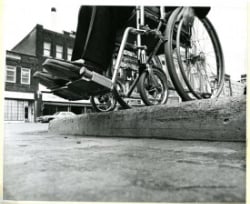By Fay Lorraine Sueltz, AIA, CASI
President George H. Bush signed the Federal Americans with Disabilities Act into Federal Law 25 years ago in 1990. The legislation ensured the right of a physically or mentally disabled person [* see footnote] to gain access to and through new government or government-funded buildings under Title II of the law and access to and through new public and commercial buildings under Title III of the law.
After the Civil Rights Act was signed in 1964, the ADA came to be law after years of legislation aiming towards ending discrimination and active protests by the disabled community. Most notable of many laws that foreshadowed the ADA was the 1973 Section 504 of the Rehabilitation Act which states:
“No otherwise qualified individual with a disability in the United States, as defined in section 705(20) of this title, shall, solely by reason of her or his disability, be excluded from the participation in, be denied the benefits of, or be subjected to discrimination under any program or activity receiving Federal financial assistance or under any program or activity conducted by any Executive agency or by the United States Postal Service”.
However, for years the Rehabilitation act was not signed until active protests in 10 American cities including the taking over of the San Francisco’s Health, Education, and Welfare Building, where a month-long sit-in and control of the building by 150 protesters took place.
Chapter 11B of the 2013 California Building Code contains code requirements for accessibility for new commercial and public buildings. The California code, being the most stringent of all state codes concerning disabled access, has informed ADA guideline revisions over the years. Chapter 11B of the 2013 CBC the current 2010 ADAAG are closely coordinated and use the same section reference numbers.
Both the ADA and the CBC have code sections concerning “barrier removal” as a requirement in existing buildings by a date close to the inception date of 1990. However, to date, 25 years later, many commercial and public buildings still have non-compliant issues. Civil lawsuit according to the State of California’s CBC and Federal lawsuit ensued and has not let up.
In California, the Jesse Unruh act led to each site infraction of the ADA to become an individual fine of $4000, which led more than a few lawyers to earn a living racking up many infractions as possible per building location, such as restroom mirror height, toilet paper holder location, etc., often filing lawsuits of $80,000 or more easily, or offering to settle for a lesser amount. Because small business owners were closing their doors due to the financial burden of fixing all ADA issues in older buildings, the State of California enacted 2 Senate Bills, SB 1608 and SB 1186, not only to limit the effect of the Unruh act to one low financial hit per occasion but also to allow the business owner the opportunity to make fixes within a time allowance and according to their budget. The new laws enforce the Certified Access Specialist program, or “CASp”. A CASp Report on a site, prior to a lawsuit offers the possibility of mediation and a time allowance to make ADA issues compliant, saving the owner from undue financial hardship. SB 1186 also requires that any new lease of a commercial building be made aware of the existence of a CASp Report on the property they are to lease.

A CASp Report or ADA survey on a property prior to the sale or leasing of such property discloses the possible remediation issues and could influence the sale price of a structure or property due to issues in high ticket items like non-compliant size elevators, many doors with no maneuverability areas, or non-existent ramps or non-compliant stairways and restrooms. It is for these reasons, that the new owner and the new lease are to be made aware of the existence of a CASp Report, as both are responsible for ADA compliance under the law. Also, many prudent developers are having their drawings for proposed buildings reviewed by certified CAS program certificate holders to help ensure the project will be ADA compliant when built.
Footnote:
(1) Definition of Disability, from the 1990 ADA:
The term “disability” means, with respect to an individual
(A) A physical or mental impairment that substantially limits one or more major life activities of such individual;
(B) A record of such an impairment; or
(C) Being regarded as having such impairment (as described in paragraph (3)).
(2) Major Life Activities
(A) In general
For purposes of paragraph (1), major life activities include, but are not limited to, caring for oneself, performing manual tasks, seeing, hearing, eating, sleeping, walking, standing, lifting, bending, speaking, breathing, learning, reading, concentrating, thinking, communicating, and working.
Images courtesy New Mobility and The Smithsonian Institute
This article was originally published by Xpera Group which is now part of The Vertex Companies, LLC.



